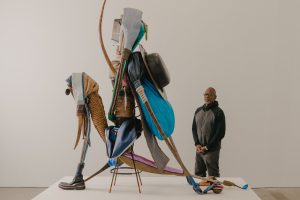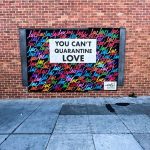 Dear Friends,
Dear Friends,
I hope you are all safe and healthy. I must admit these last couple of weeks have knocked the wind out of me. I have written an essay a week for almost five years now—no matter what—an essay a week. But in the last two weeks I had nothing to share. We have all been trying to sort out the current conditions, perhaps going through some of the stages of grief on our way to making a kind of peace with this dreadful new reality. Suddenly, a virus, a quarantine, and a new world. What place does art have in this new reality? What can artists do when separated from studios, community, materials, and their practice?
 This last month the artist Daniel Lind-Ramos found himself stuck in New York, unable to return to his home in Puerto Rico. He spent the time alone in an apartment, sketching and drawing. In a recent New York Times piece, Lind-Ramos, who survived Hurricane Maria, notes:
This last month the artist Daniel Lind-Ramos found himself stuck in New York, unable to return to his home in Puerto Rico. He spent the time alone in an apartment, sketching and drawing. In a recent New York Times piece, Lind-Ramos, who survived Hurricane Maria, notes:
We have to take everything that is within our reach to create images, I’m not in my studio, but I have paper, pens, pencils. So I can react to the situation.
The article notes that, “crisis also shakes up the visual language, the system of signs, as familiar objects or even colors take on enhanced meanings, while others spring from nowhere to take center stage.”
In short, the world suddenly looks very different, especially so to artists and creative people for whom the daily practice of self-expression and self-knowledge is made possible by access, mobility, material, and space in which to practice their art form.
Things have changed rapidly since I last wrote in this space. Our students and faculty have had to move out of their studios, classrooms, and labs, and we are all teaching and learning online from wherever we are sheltered. While our work goes on, albeit in isolation, geographically my own world has become considerably smaller. When not working, I am reading Wanderlust by Rebecca Solnit, going for solitary walks, and listening to music that makes me cry… Springsteen’s The Rising, old Bob Dylan and his unexpected new epic 17-minute song Murder Most Foul; music from a different time that touches me now in a different way, comfort music that allows for my personal emotional response to the crisis. I am thinking about Gabriel Garcia-Marquez’s books like Love in the time of Cholera and 100 years of Solitude and Samuel Beckett’s plays like The Unnamable (“you must go on, I can’t go on, I’ll go on”). I am watching winter turn to spring outside my windows and looking forward to planting a garden. And I am also worrying constantly about our students, colleagues and extended community of artists, family, and friends that are coping with this terrifying moment.
Our students and faculty are coping with a very real sense of dislocation, as are our communities beyond academia. We hear the phrase “existential crisis” deployed for any number of conditions, but for artists, social distancing and forced separation from the work in which identities are often forged is a very real matter of psychic if not financial existence. I won’t repeat the now familiar tropes we have all heard recently about how we will get through this (of course we will). However, now is about the time we are entering into the ugly period of such a crisis. This is where we start to gut it out, where the newness and the we-can-do-it spirit begins to wane. As we rise from the grief, this is where we need to really dig in. For ourselves, for our families and friends, and for our students. Our amazing faculty and staff are making heroic efforts to make sure that our community is safe and continuing to learn within this new model of distance education and the loneliness that comes with isolation. It is a moving target, but we are all being as vigilant as possible as we evolve with every new challenge.
Some of our third-year graduate students are caught in the rapidly evolving realities of the pandemic and many have been unable to publicly exhibit their work after three years of preparation and growth. We want to share that work with you, so below, you will see documentation of some of our students’ virtual MFA exhibitions. We will use this space to continue to showcase the work of our amazing graduate students for the rest of the semester. We also want to keep track of our current undergraduate students, alumni, and friends as well. Please tell us how you are coping with this crisis. Share your stories and images with us at artfrontdesk@education.wisc.edu.

You Can’t Quarantine Love. Mural by Ruben Rojas
We are a strong and wonderful community of artists and friends, all deeply connected through our relationship to the UW-Madison Art Department. So, for now, be well and please take care of yourselves and each other.
Douglas Rosenberg
Chair, UW-Madison Art Department
